Transportation in California

California's transportation system is complex and dynamic. Although known for its car culture and extensive network of freeways and roads, the state also has a vast array of rail, sea, and air transport. Several subway, light rail, and commuter rail networks are found in many of the state's largest population centers. In addition, with the state's location on the West Coast of the United States, several important ports in California handle freight shipments from the Pacific Rim and beyond. A number of airports are also spread out across the state, ranging from small general aviation airports to large international hubs like Los Angeles International Airport and San Francisco International Airport.
However, in a state with over 39 million people, rapid population expansion, and diverse terrain and weather, that system is under pressure to stay ahead of population growth and transportation needs.

Roads and highways
[edit]

California is known for its car culture; by the end of 2010, the California Department of Motor Vehicles had 23,799,513 driver's licenses and a total of 31,987,821 registered vehicles on file.[1] The state's residents typically take to the roads for their commutes, errands, and vacations, giving California's cities a reputation for severe traffic congestion.
California's vast terrain is connected by an extensive system of freeways, expressways, and highways, all maintained by the California Department of Transportation (Caltrans) and patrolled by the California Highway Patrol (CHP), except for the numbered expressways in Santa Clara County which were built and maintained by the county itself. The main north–south arteries are U.S. Route 101 (US 101), which travels close to the coast from Downtown Los Angeles, across the Golden Gate Bridge, and to the Oregon state line, and Interstate 5 (I-5), which travels inland from the Mexico–United States border to the Oregon state line, effectively bisecting the entire state. In addition, a major north–south artery is State Route 99 (SR 99), which travels from near Bakersfield to near Red Bluff; SR 99 is largely parallel to I-5, and connects the Central Valley cities not connected by the Interstate.
Perhaps it is a testament to California's sheer size that although it has one of the most extensive freeway systems in the United States, it contains many of the largest cities in the United States not served by an Interstate Highway, including the two largest, Fresno (pop. 471,479) and Bakersfield (pop. 247,057).[2] These cities, along with Modesto and Visalia, are passed by as I-5 veers west to avoid the congestion of the populated eastern side of the Central Valley as it connects Sacramento and Los Angeles.[3]
The state's freeway network has expanded ever since the Arroyo Seco Parkway, the first freeway in the Western United States,[4] connecting Los Angeles and Pasadena, opened in 1940. However, the state is not immune to freeway revolts, such as those that have prevented a freeway in San Francisco between the Golden Gate Bridge and the San Francisco–Oakland Bay Bridge, and an expansion of I-710 through South Pasadena.
Traffic signs, road surface markings, and traffic signals on all public streets and highways throughout the state are regulated by the California Vehicle Code and standardized in the California Manual on Uniform Traffic Control Devices.
Toll roads and bridges
[edit]
Almost all California highways are non-toll roads, including several major non-toll bridges in Los Angeles, Sacramento, and San Diego. However, there are four toll roads in Southern California, and eight toll bridges in the San Francisco Bay Area (including the state's most famous highway bridge, the Golden Gate Bridge). These toll facilities, along with several high-occupancy toll lanes, use the statewide electronic toll collection system known as FasTrak.
| SF Bay Area toll bridges | So. California toll roads |
|---|---|
|
Interstate Highways
[edit]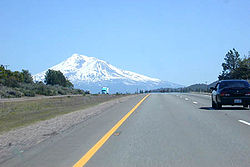

Primary Interstate Highways in California include:
| Interstate 5: Bisects the state from the Mexican border to Oregon, linking the major cities of San Diego, Santa Ana, Los Angeles, Stockton, Sacramento, and Redding. | |
| Interstate 8: Travels east from San Diego to the Imperial Valley before crossing into Arizona west of Yuma. | |
| Interstate 10: Travels east from Santa Monica through Los Angeles, San Bernardino, and the Coachella Valley to Arizona. | |
| Interstate 15: Originating from San Diego, serves as the major route from Southern California to Las Vegas, Nevada. | |
| Interstate 40: Travels east from Barstow across the Mojave Desert to Needles before entering into Arizona. | |
| Interstate 80: Travels northeast from San Francisco through Sacramento and over the Sierra Nevada mountain range before crossing into Nevada west of Reno. |
Auxiliary (three-digit) Interstates are located in the Greater Los Angeles area, the Bay Area, and the San Diego Area:
- Greater Los Angeles Area
- San Francisco Bay Area
- San Diego Area
U.S. Routes
[edit]
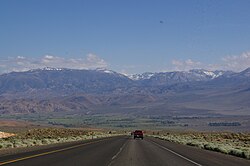
The following are United States Numbered Highways in California:
| US 6: Travels from Bishop east to Central Nevada. | |
| US 50: Heads east from the Sacramento area through the South Lake Tahoe area before crossing into Nevada en route to Carson City. | |
| US 95: Enters into California from Arizona through a concurrency with I-10. US 95 then splits from I-10 in Blythe, then travels north to Needles before crossing into Nevada en route to Las Vegas | |
| US 97: Serves as the primary connection from the City of Weed to Klamath Falls, Oregon. | |
| US 101: The primary north-south U.S. Highway in California, connecting Los Angeles with the Central Coast, the San Francisco Bay, and the North Coast. | |
| US 199: Serves as the primary connection from the Crescent City area to Grants Pass, Oregon. | |
| US 395: A major north–south route in the eastern areas of the state, connecting the Mojave Desert with the Owens Valley and the Eastern Sierra Nevada. The route then clips into Nevada to pass through Carson City and Reno, before returning to California to serve the Honey Lake and Modoc Plateau areas. |
California still uses an older, cut-out version of the U.S. Route shield instead of the current design used in the other U.S. states, printed on a square blank with a black background.
State Routes
[edit]

State highways in California range from one-lane rural roads to full urban freeways. Each state highway is assigned a Route (officially State Highway Route[5][6]) number in the Streets and Highways Code (Sections 300–635). However, the state is also currently relinquishing a number of non-freeway segments, especially in urban areas, and turning them over to local control.[7]
The standard California state route marker consists of a white numeral on a green shield, with the name "California" displayed above the numeral. The shield is shaped like a miners' spade to honor the California Gold Rush.[8][9]
Major long-distance, intercity state routes include:
| State Route 1: Runs along most of the Pacific coastline from Dana Point north to Leggett. It links numerous coastal settlements, beaches, parks, and other attractions in the Greater Los Angeles Area, the Central Coast, the San Francisco Bay Area, and the North Coast. | |
| State Route 41: Runs northeast, connecting the Central Coast with the central San Joaquin Valley, Fresno, and Yosemite National Park. | |
| State Route 46: Heads east from the Central Coast to the southern San Joaquin Valley near the vicinity of Bakersfield. | |
| State Route 49: Known as the Gold Country Highway, SR 49 links many historic mining communities of the California Gold Rush. | |
| State Route 58: Although the western segment of SR 58 is a winding mountain road connecting the Central Coast to the southern San Joaquin Valley, its eastern segment is a major artery linking Bakersfield with the Mojave Desert and Barstow. | |
| State Route 99: Serves as a major north–south artery in the California Central Valley, linking major cities such as Bakersfield, Visalia, Fresno, Madera, Merced, Modesto, Stockton, Sacramento, Yuba City, and Chico. | |
| State Route 152: Heads east from the Monterey Bay Area to the Santa Clara Valley and the Central Valley. | |
| State Route 299: Runs east across the northern part of the state from the Eureka area to Redding and Alturas. |
County routes
[edit]County routes in California are controlled and maintained by the respective counties in which they reside, but are normally patrolled by the California Highway Patrol like any other state highway. Each county route is prefixed with a letter, depending on the region of the state (e.g. G2). Routes with letters A, B, and D are in the region of Northern California; letters E, G, and J are in Central California; and N, R, and S are in Southern California. County routes can range from two-lane roads to the full expressways found in Santa Clara County.
Rail travel
[edit]Although known for its car culture, California also has a number of local and regional passenger rail systems, including the following:
| System | Image | Type | No. of lines | Length (mi) | Length (km) | No. of stations | Description |
|---|---|---|---|---|---|---|---|
 | Commuter rail | 1 | 85 | 137 | 10 | The Altamont Commuter Express, also known as ACE, runs from San Jose northeast to Stockton, providing service from the Silicon Valley to Eastern Alameda County and San Joaquin County. | |
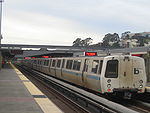 | Heavy rail, light rail, automated guideway transit | 6 | 131 | 211 | 50 | Bay Area Rapid Transit (BART) operates in the San Francisco Bay Area, connecting San Francisco with cities in the East Bay and suburbs in northern San Mateo County. | |
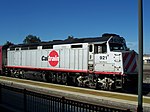 | Commuter rail | 1 | 77 | 124 | 31 | Caltrain runs from San Francisco south down the San Francisco Peninsula to the Silicon Valley and has a further extension south to Gilroy, California. The route from San Francisco to San Jose will be fully electrified by 2025. | |
 | Commuter rail | 1 | 41 | 66 | 8 | The San Diego Coast Express Rail (COASTER) operates in the central and northern coastal regions of San Diego County, running from San Diego north to Oceanside. | |
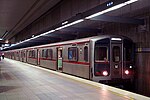 | Heavy and light rail | 6 | 109 | 175 | 102 | Metro Rail is an integrated subway and light rail system serving Los Angeles County. | |
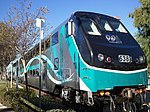 | Commuter rail | 8 | 546 | 879 | 69 | Metrolink serves Los Angeles and the surrounding area of Southern California, connecting Los Angeles, San Diego, Orange, Riverside, San Bernardino and Ventura Counties. | |
 | Light rail | 7 | 39 | 63 | 117 | Muni Metro is a premetro/light rail system connecting various neighborhoods and districts of San Francisco. | |
 | Light rail | 3 | 43 | 69 | 53 | The Sacramento Regional Transit District (RT) light rail system serves Sacramento and vicinity. | |
 | Light rail | 5 | 65 | 105 | 62 | The San Diego Trolley serves the metropolitan area of San Diego. It runs from La Jolla in the north to San Ysidro in the south, and from Old Town and downtown San Diego in the west to El Cajon and Santee in the east. | |
 | Streetcar | 3 | 5 | 8.0 | 62 | The world's last manually operated cable car system continues to operate in northeast San Francisco on its very steep hills, but the system's small service area and premium fares for single rides currently make the cable cars used more as a tourist attraction. | |
 | Commuter rail | 1 | 45 | 72 | 12 | Sonoma–Marin Area Rail Transit (SMART) runs through Sonoma and Marin counties. | |
 | Diesel light rail | 1 | 22 | 35 | 15 | The SPRINTER operates in north region of San Diego County, running from Oceanside east to Escondido. | |
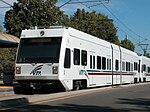 | Light rail | 3 | 42 | 68 | 60 | The Santa Clara Valley Transportation Authority (VTA) light rail system serves San Jose and its suburbs in the Silicon Valley. |
Amtrak
[edit]
Amtrak California is a collection of services supported by Amtrak and the California Department of Transportation. The three busiest intercity rail lines in the US outside the Northeast Corridor operate under this branding: the Capitol Corridor connects the San Francisco Bay Area to Sacramento; the Pacific Surfliner runs along the coast of Southern California from San Diego to San Luis Obispo; and the San Joaquin connects the major cities of the San Joaquin Valley with onward service to either the Bay Area or Sacramento.
National Amtrak lines include the California Zephyr from Emeryville to Chicago, Illinois; the Coast Starlight from Los Angeles to Seattle, Washington; the Southwest Chief and the Texas Eagle from Los Angeles to Chicago; and the Sunset Limited from Los Angeles to New Orleans, Louisiana.


 French
French Deutsch
Deutsch